PR
X
Keyword Search
▼キーワード検索
Comments
続日本100名城東北の…
New!
オジン0523さん
2025年版・岡山大学… New!
隠居人はせじぃさん
New!
隠居人はせじぃさん
【甥のステント挿入… Gママさん
Gママさん
ムベの実を開くコツ… noahnoahnoahさん
noahnoahnoahさん
エコハウスにようこそ ecologicianさん
2025年版・岡山大学…
 New!
隠居人はせじぃさん
New!
隠居人はせじぃさん【甥のステント挿入…
 Gママさん
Gママさんムベの実を開くコツ…
 noahnoahnoahさん
noahnoahnoahさんエコハウスにようこそ ecologicianさん
Calendar
カテゴリ: 海外旅行
観光案内所「Galway Tourist Information Centre」
のフェンスに掲げられていた
アイルランドの写真
「 The Battle of Aughrim Nic Dunlop
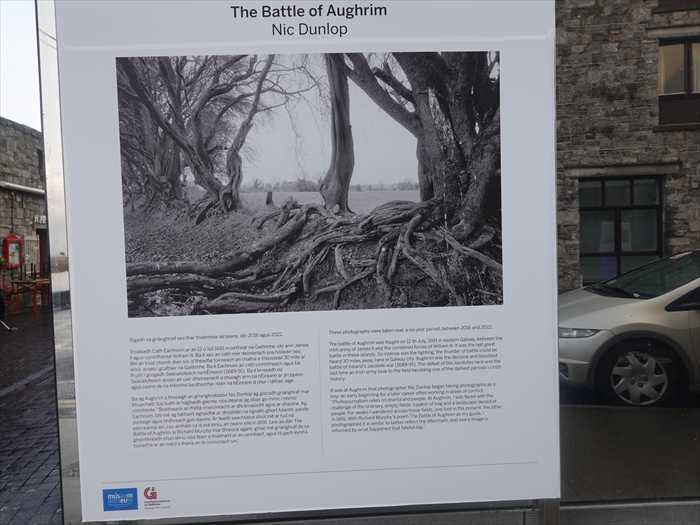
「"At the very top of the hill, cavalry were mixed with infantry. The firing was so intense
that the ridges seemed to be ablaze. As dusk fell, the cavalry began to move away and
take flight, abandoning the infantry, who, in turn threw down their arms, left their
colours and ran."
— A Danish eyewitness account」
【丘の頂上では、騎兵と歩兵が入り混じっていた。銃撃は非常に激しく、尾根がまるで燃えて
いるように見えた。夕暮れが迫ると、騎兵は後退して逃げ始め、歩兵を見捨てた。歩兵は次々と
― あるデンマーク人の目撃証言】

「And a rook tied by the leg to scare flocks of birds /Croaks as I dismount at the death
cairn of St Ruth:
【そして群れをなす鳥たちを追い払うため、足を縛られたミヤマガラスが /
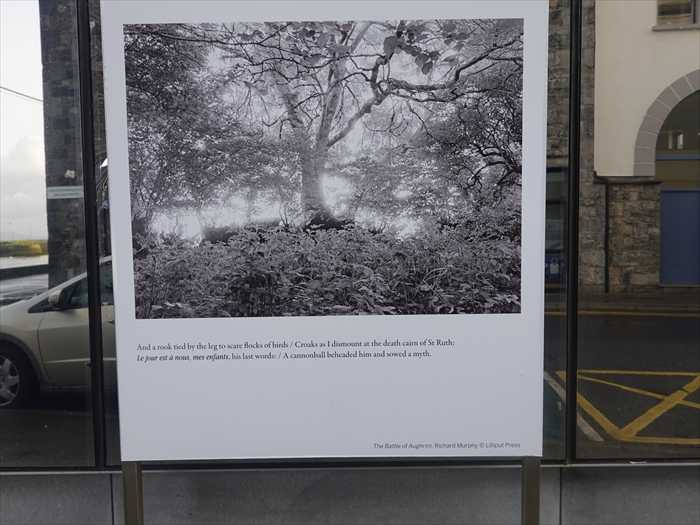
「“The blood from the dead so covered the ground that one could hardly take a step
without slipping. This grisly scene of slaughter remained untouched and unchanged
for several days, the horror of which cannot be imagined except by those who saw it.”
— A Danish eyewitness account」
【死者の血が地面を覆い尽くし、一歩踏み出すことさえ滑らずにはできなかった。この凄惨な
者にしか想像できない。」
― あるデンマーク人の目撃証言】

「Behind the dog-rose ditch, defended with pikes, /
【ドッグローズ(野バラ)の生け垣の裏側、かつて槍で守られた塹壕の向こうに、
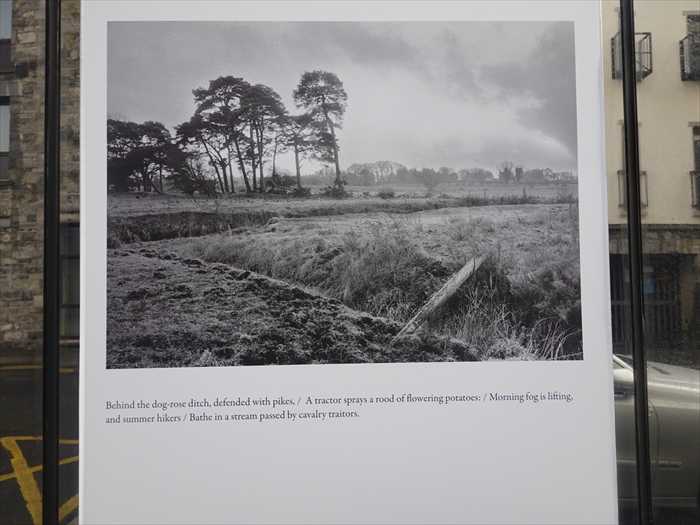
「Aughrim’s great disaster /
【アスリムの大災厄が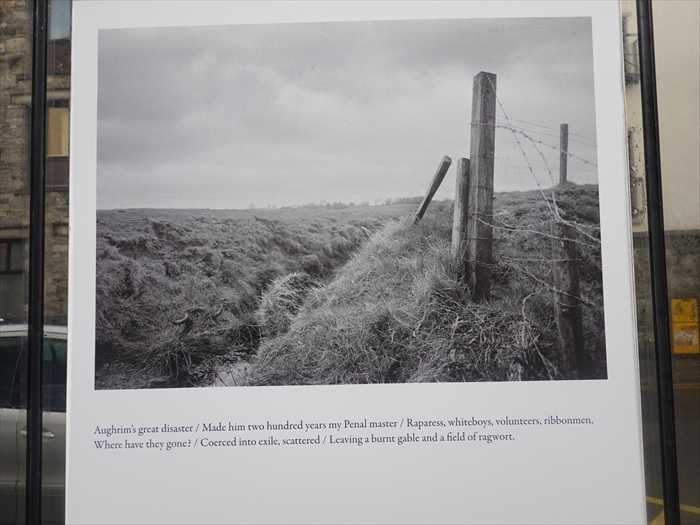
「“The Irish laid so close in their ditches, that several were doubtful whether they had
any men at that place or not: but they were convinced of it at last; for no sooner were
the French, and the rest, within twenty yards, or less, of the ditches, the Irish fired most furiously upon them; which our men bravely sustained, and pressed forwards, though
they could scarce see one another for smoke.”
【アイルランド兵は自軍の塹壕の中に極めて身を潜めていたため、多くの者が本当にそこに
兵がいるのか疑うほどだった。しかしついにそれが事実であることを思い知った。なぜなら、
フランス兵や他の兵がその塹壕に20ヤード(約18メートル)以内に近づいたとたん、
アイルランド兵たちは猛烈な銃撃を浴びせたからである。我が軍の兵士たちはこれを勇敢に耐え、
前進を続けたが、煙のせいで互いの姿をほとんど見分けることができなかった。
— ジョージ・ストーリー牧師『公正なる歴史』より】

「He sees men run to the skyline /
【彼は、男たちが地平線へと逃げ走るのを見た。
マスケット銃や槍を投げ捨てながら
その後、サーベルを抜いた騎兵たちが
彼らを斬り伏せていった。
ーアイルランドの詩人 リチャード・マーフィー(Richard Murphy, 1927–2018) による詩集
『The Battle of Aughrim(アスリムの戦い)』からの引用であり、出版元はダブリンの
Lilliput Press(リリパット・プレス)】
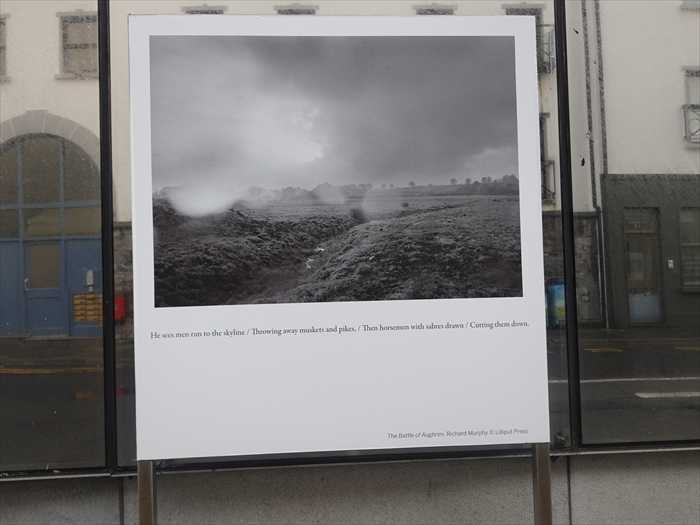
「Deep red bogs divided / Aughrim, the horse’s ridge /
「Who owns the land where musket-balls are buried /
【マスケット弾が埋もれたこの土地は誰のものか
ーアイルランドの詩人 リチャード・マーフィー(Richard Murphy, 1927–2018) による詩集
『The Battle of Aughrim(アスリムの戦い)』からの引用であり、出版元はダブリンの
Lilliput Press(リリパット・プレス)】
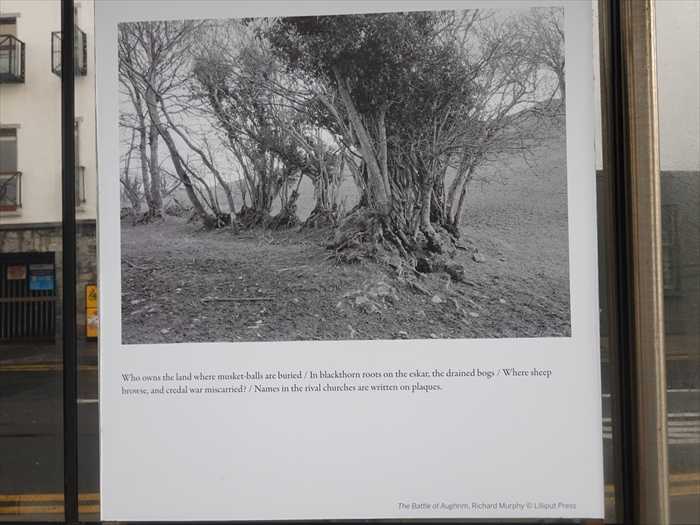
「I dream of a headless man /
【私は首を失った男の夢を見る
地主のために。
ーアイルランドの詩人 リチャード・マーフィー(Richard Murphy, 1927–2018) による詩集
『The Battle of Aughrim(アスリムの戦い)』からの引用であり、出版元はダブリンの
Lilliput Press(リリパット・プレス)】
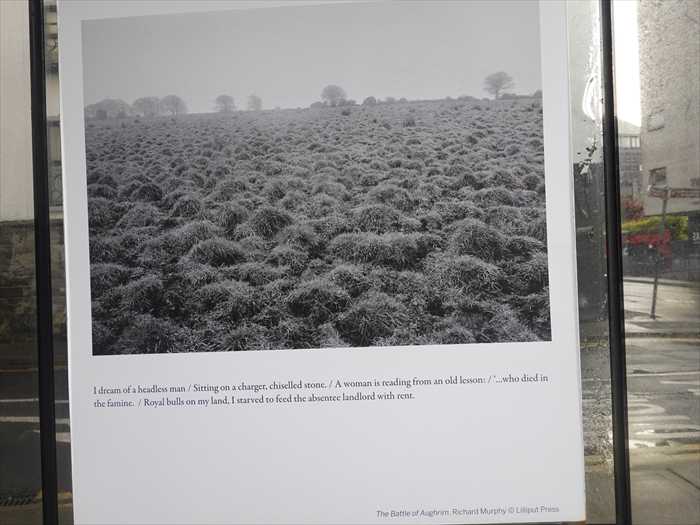
「Flies gyrate in their galaxy above my horse’s head /
【蠅が銀河のように、馬の頭の上を旋回する馬がのんびり歩きながら、ナショナル・スクールの近くで身をすくめる
ガラスの下にある銃弾、パトリック・サースフィールドの
「神よ、かくあれかし……」
そして私は鞍もなく、戦の丘へと向かう道で跳ね上がる。
ーアイルランドの詩人 リチャード・マーフィー(Richard Murphy, 1927–2018) による詩集
『The Battle of Aughrim(アスリムの戦い)』からの引用であり、出版元はダブリンの
Lilliput Press(リリパット・プレス)】

「In opposite camps our ancestors /
【敵対する陣営に分かれていた我らの祖先
ーアイルランドの詩人 リチャード・マーフィー(Richard Murphy, 1927–2018) による詩集
『The Battle of Aughrim(アスリムの戦い)』からの引用であり、出版元はダブリンの
Lilliput Press(リリパット・プレス)】
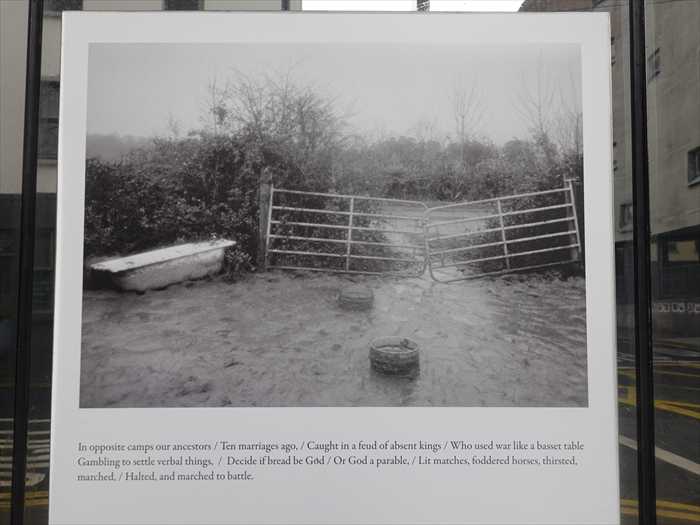
「The story I have to tell /
【私が語らねばならぬ物語は
『The Battle of Aughrim(アスリムの戦い)』からの引用であり、出版元はダブリンの
Lilliput Press(リリパット・プレス)――私が語らねばならぬ物語を。】

地元アーティストによる小規模なパブリックアートであろうか??
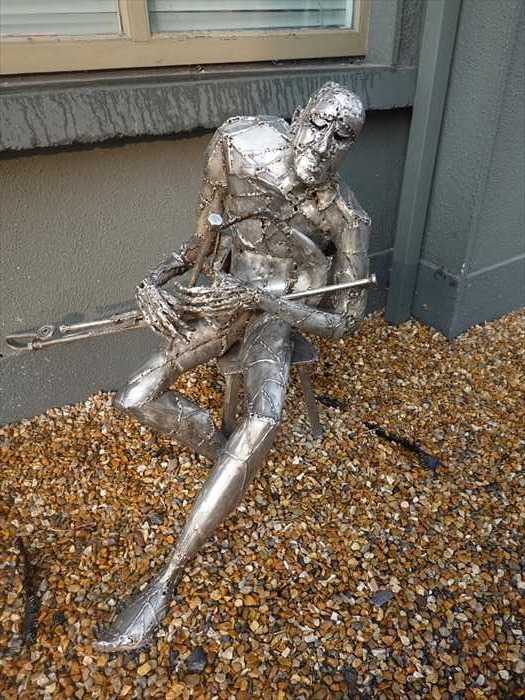
正面を道なりに左折。
R336とDock Street・ドックストリートとの交差点角にあったあった建物・
「 Steamship House(スチームシップ・ハウス) 」。
かつての蒸気船関連の倉庫や事務所として使われていた歴史的建築です。地元で長い歴史を持つ
建物であり、象徴的な産業遺産として現在は改装され、さまざまなオフィスや事業所が入居。

前方右手に マリーナ・Port of Galway が姿を現した。
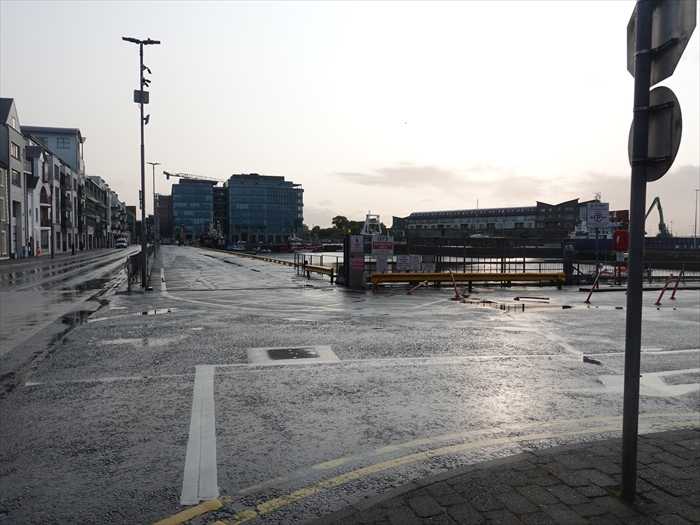
この建物の壁にあった青い記念プレート(ブルー・プラーク)は、アイルランド・ゴールウェイの
文筆家 Pádraic Ó Conaire(パードリック・オ・コナーラ) を讃えるもの。
この建物は、ジェームズ・コノリーが1868年に生まれた場所とされており、ゴールウェイにおける
歴史的スポットの一つ。現代では飲食店となっていますが、歴史的建築物としての記憶がこの
ブループラークに刻まれているのだと。
「GALWAY LIONS CLUB
【ゴールウェイ・ライオンズ・クラブ
パードリック・オ・コナーラ
(1882–1923)
ゴールウェイ出身の著名な作家の生誕地。彼の作品の大半は
アイルランド語で出版された。
ゴールウェイ市民信託】

朝の ゴールウェイ港(Galway Harbour)のドックエリア(Galway Docks)を見る。
この ゴールウェイ港(Galway Harbour)の先端にマリーナ・Port of Galway があり、
アイルランド3日目の6月2日(月)に楽しんだ Aran Islands(アラン諸島)・Inishmore
(イニシュモア)島への観光フェリー はここから出港したのであった。
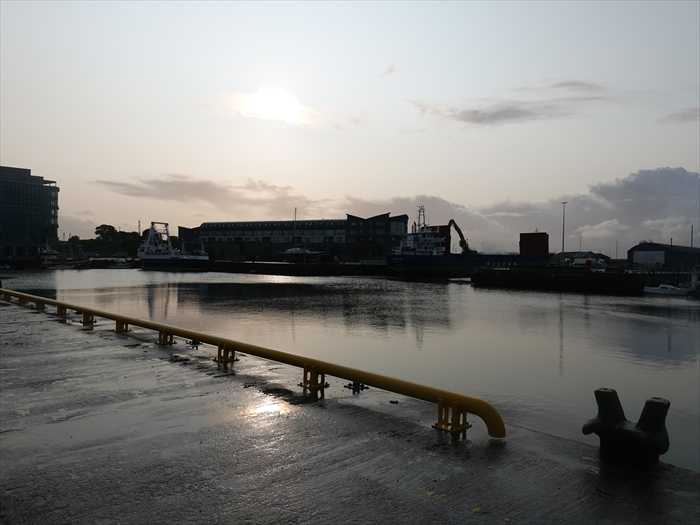
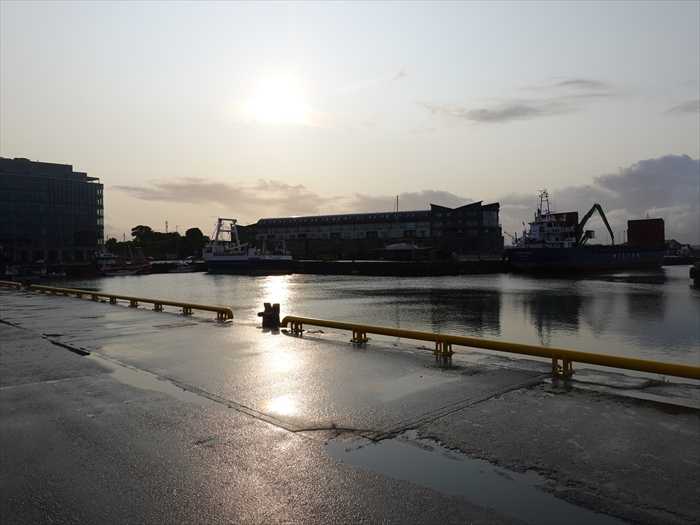
様々な船舶が停泊中。
停泊している船舶の中には、作業船(タグボートや浚渫船)も含まれており、港湾整備に
関与しているのであろう。

「 United Presbyterian and Methodist Church」(合同長老・メソジスト教会)」。
プロテスタント系のメソジストおよび長老派合同教会であり、現在も現役の礼拝施設である。

「United Presbyterian & Methodist Church, Galway
Sunday Worship 11:15 a.m.
(and other information about congregation)」と。
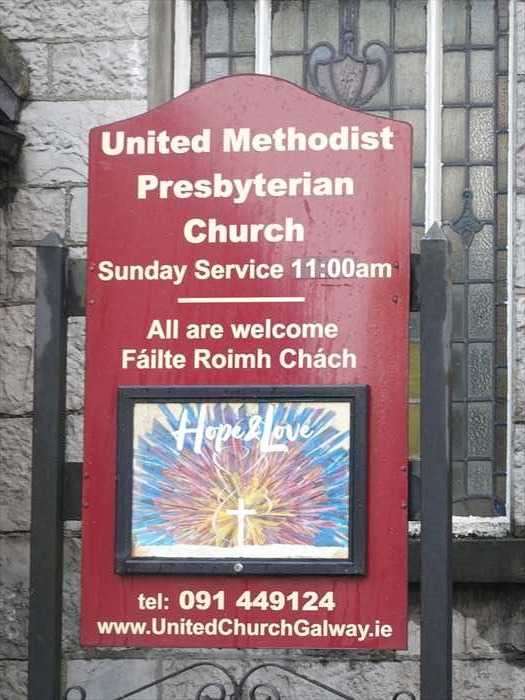
「Eyre Square Centre(エア・スクエア・センター)」の西側入り口と、その隣接する
歴史的石造建築。
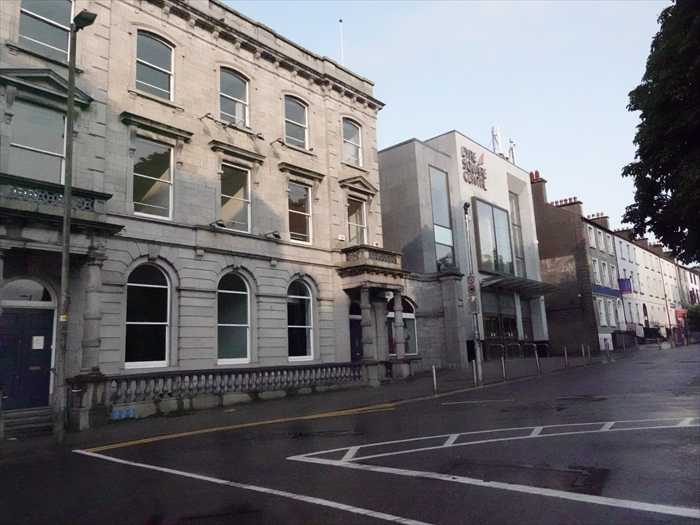
ゴールウェイの「旧鉄道駅構内(Eyre Square / Ceannt Station)付近」にある特徴的な建物群。
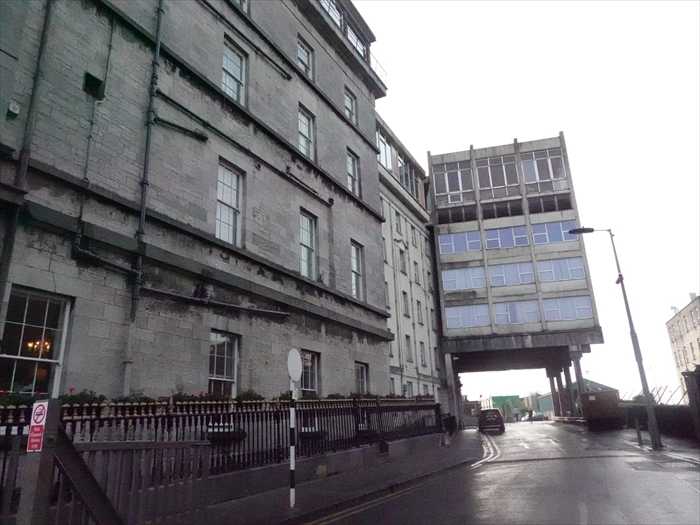
「Ceannt Station(ケアント駅)」前を通過。
アイルランド国鉄(Iarnród Éireann)のゴールウェイ駅(Galway Railway Station)の
正式名称 であると。
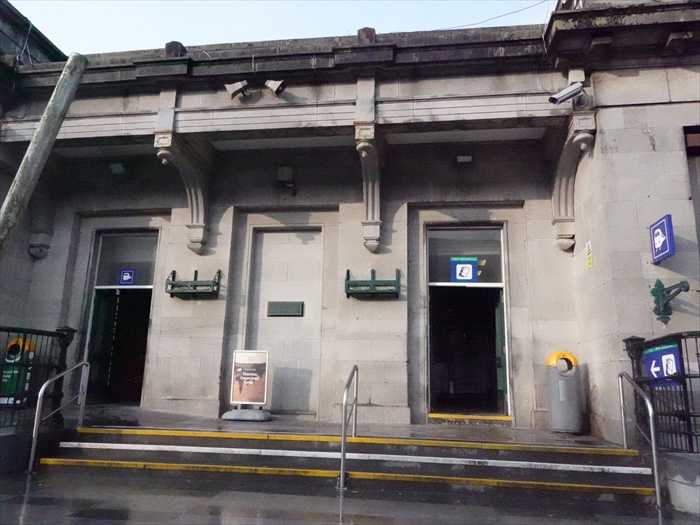
「To commemorate the 1916 Rising this building was named
Éamonn Ceannt Station in honour of Éamonn Ceannt」
【1916年の蜂起を記念して、この建物はエーモン・ケアントに敬意を表し、
「エーモン・ケアント駅」と名付けられました。】
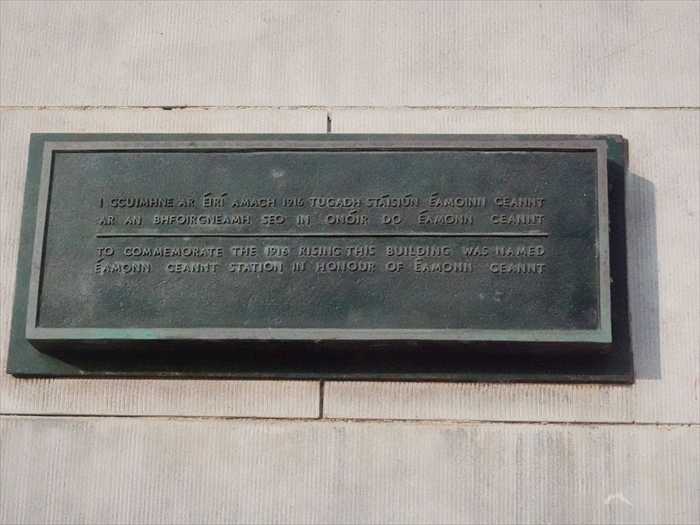
約1.5時間の早朝散歩 であった。
Corrib川に沿ったGalwayの街の中にあった教会、史跡等を訪ねることが出来た のであった。
そして3連泊したアパートメントに無事到着。時間は7:34。
「 eata na Cathrach - Galway Lakeside Apartments 」

アパートメントに入るためのパスワード入力端末がこれ。

・・・もどる・・・
・・・つづく・・・
アイルランドの写真
「 The Battle of Aughrim Nic Dunlop
These photographs were taken over a six year period, between 2016 and 2022.
The Battle of Aughrim was fought on 12 July, 1691 in eastern Galway, between
the Jacobite army under the command of James II and the combined forces of
William III. It was the last great battle on Irish soil. Estimates of the dead run
to 7,000. Sometimes who was fighting, the thunder of battle could be heard
as far as Galway city. Aughrim was one of the decisive and bloodiest battles
in Irish history, one which sealed William’s takeover (1690–91) of the throne of
James II. For the defeated, the Irish army took to the field, signalling one of the
darkest periods in Irish history.
the Jacobite army under the command of James II and the combined forces of
William III. It was the last great battle on Irish soil. Estimates of the dead run
to 7,000. Sometimes who was fighting, the thunder of battle could be heard
as far as Galway city. Aughrim was one of the decisive and bloodiest battles
in Irish history, one which sealed William’s takeover (1690–91) of the throne of
James II. For the defeated, the Irish army took to the field, signalling one of the
darkest periods in Irish history.
It was at Aughrim that photographer Nic Dunlop began taking photographs as a
meditation on the passage of time after war, often working in areas of conflict himself.
The series highlights different markers of man and place at Aughrim and in landscape
west of the Shannon. As with all Dunlop’s documentary works, ordinary faces, a footpath,
a tree, the bend of the road, form part of the terrain of memory. The Battle of Aughrim
was my guide. The Irish author Richard Murphy’s poem “The Battle of Aughrim” is
used as the title. I began photographing the field in winter to better reflect the
aftermath, and every image is haunted by the need to narrate not only what happened,
but why it happened that fateful day.
【これらの写真は2016年から2022年にかけて6年間撮影されたものです。
meditation on the passage of time after war, often working in areas of conflict himself.
The series highlights different markers of man and place at Aughrim and in landscape
west of the Shannon. As with all Dunlop’s documentary works, ordinary faces, a footpath,
a tree, the bend of the road, form part of the terrain of memory. The Battle of Aughrim
was my guide. The Irish author Richard Murphy’s poem “The Battle of Aughrim” is
used as the title. I began photographing the field in winter to better reflect the
aftermath, and every image is haunted by the need to narrate not only what happened,
but why it happened that fateful day.
【これらの写真は2016年から2022年にかけて6年間撮影されたものです。
アスリムの戦いは1691年7月12日にゴールウェイ東部で行われました。ジェームズ2世に忠誠を
誓うジャコバイト軍と、ウィリアム3世の連合軍との間で戦われたこの戦いは、アイルランドの
地で行われた最後の大規模な戦いでした。死者は7,000人に達したとも言われます。戦の轟音は、
遠くゴールウェイ市にまで届いたとされています。この戦いは、アイルランド史上最も決定的で
流血の多い戦闘の一つであり、ジェームズ2世に対するウィリアムの王位奪取(1690–91)を
決定づけたものでした。敗北したアイルランド軍が戦場に身を投じたことは、アイルランド史の
中でも最も暗い時代の始まりを象徴しています。
誓うジャコバイト軍と、ウィリアム3世の連合軍との間で戦われたこの戦いは、アイルランドの
地で行われた最後の大規模な戦いでした。死者は7,000人に達したとも言われます。戦の轟音は、
遠くゴールウェイ市にまで届いたとされています。この戦いは、アイルランド史上最も決定的で
流血の多い戦闘の一つであり、ジェームズ2世に対するウィリアムの王位奪取(1690–91)を
決定づけたものでした。敗北したアイルランド軍が戦場に身を投じたことは、アイルランド史の
中でも最も暗い時代の始まりを象徴しています。
写真家ニック・ダンロップは、このアスリムの地で戦後の時間の経過を見つめる瞑想的な
作品作りを始めました。彼自身も多くの紛争地で活動してきた経験があり、このシリーズでは
アスリムやシャノン川以西の風景にある人間と場所の痕跡を強調しています。彼の他の
ドキュメンタリー作品と同様に、普通の顔、道、木々、曲がりくねった道が記憶の地形の一部を
成しています。このプロジェクトの指針となったのはアイルランド人作家リチャード・
マーフィーの詩「The Battle of Aughrim」でした。私は戦いの余韻をより鮮明に映し出すために
冬に撮影を始めました。そしてすべての写真には、あの日何が起こったのか、そしてなぜそれが
起こったのかを語り継ぐ必要性が宿っています。】
作品作りを始めました。彼自身も多くの紛争地で活動してきた経験があり、このシリーズでは
アスリムやシャノン川以西の風景にある人間と場所の痕跡を強調しています。彼の他の
ドキュメンタリー作品と同様に、普通の顔、道、木々、曲がりくねった道が記憶の地形の一部を
成しています。このプロジェクトの指針となったのはアイルランド人作家リチャード・
マーフィーの詩「The Battle of Aughrim」でした。私は戦いの余韻をより鮮明に映し出すために
冬に撮影を始めました。そしてすべての写真には、あの日何が起こったのか、そしてなぜそれが
起こったのかを語り継ぐ必要性が宿っています。】

「"At the very top of the hill, cavalry were mixed with infantry. The firing was so intense
that the ridges seemed to be ablaze. As dusk fell, the cavalry began to move away and
take flight, abandoning the infantry, who, in turn threw down their arms, left their
colours and ran."
— A Danish eyewitness account」
【丘の頂上では、騎兵と歩兵が入り混じっていた。銃撃は非常に激しく、尾根がまるで燃えて
いるように見えた。夕暮れが迫ると、騎兵は後退して逃げ始め、歩兵を見捨てた。歩兵は次々と
― あるデンマーク人の目撃証言】

「And a rook tied by the leg to scare flocks of birds /Croaks as I dismount at the death
cairn of St Ruth:
Le jour est à nous, mes enfants, his last words: /A cannonball beheaded him and
sowed a myth.
— The Battle of Aughrim, Richard Murphy © Lilliput Press」 sowed a myth.
【そして群れをなす鳥たちを追い払うため、足を縛られたミヤマガラスが /
私がセント・ルースの死のケルンに降り立つと鳴き声を上げる:
「今日は我らのものだ、子らよ(Le jour est à nous, mes enfants)」と、彼の最期の言葉: /
砲弾が彼の首を跳ね、そして神話が蒔かれた。
— 『アスリムの戦い』リチャード・マーフィー著(リリパット・プレス刊)】
「“The blood from the dead so covered the ground that one could hardly take a step
without slipping. This grisly scene of slaughter remained untouched and unchanged
for several days, the horror of which cannot be imagined except by those who saw it.”
— A Danish eyewitness account」
【死者の血が地面を覆い尽くし、一歩踏み出すことさえ滑らずにはできなかった。この凄惨な
者にしか想像できない。」
― あるデンマーク人の目撃証言】
この証言は、1691年7月12日のアスリムの戦いの結果として広がった戦場の阿鼻叫喚と死の光景を
非常に生々しく描写しています。
非常に生々しく描写しています。
当時、戦死者は推定7,000人にのぼり、その多くが戦場に放置されたままだったとされています。
血にまみれた地面という描写は、戦闘の激しさと死の密度を物語っており、単なる数字では
捉えきれない「戦争の現実」が伝わって来るのであった。
捉えきれない「戦争の現実」が伝わって来るのであった。

「Behind the dog-rose ditch, defended with pikes, /
A tractor sprays a rood of flowering potatoes: /
Morning fog is lifting, and summer hikers /
Bathe in a stream passed by cavalry traitors.」【ドッグローズ(野バラ)の生け垣の裏側、かつて槍で守られた塹壕の向こうに、
トラクターが一反の花咲くジャガイモ畑に薬剤を散布している。
朝もやは晴れゆき、夏のハイカーたちが

「Aughrim’s great disaster /
Made him two hundred years my Penal master /
Raparees, whiteboys, volunteers, ribbonmen,
Where have they gone? /
Coerced into exile, scattered /
Leaving a burnt gable and a field of ragwort.」 【アスリムの大災厄が
あの男を200年にわたる私の刑罰の主とした
ラパリー(義賊)、ホワイトボーイズ、義勇兵、リボン党たちよ
彼らはどこへ行った?
追放され、散り散りにされ
焼け落ちた妻壁(切妻)と、キオンの野にそれを残して。】

「“The Irish laid so close in their ditches, that several were doubtful whether they had
any men at that place or not: but they were convinced of it at last; for no sooner were
the French, and the rest, within twenty yards, or less, of the ditches, the Irish fired most furiously upon them; which our men bravely sustained, and pressed forwards, though
they could scarce see one another for smoke.”
— The Reverend George Story
An Impartial History」 【アイルランド兵は自軍の塹壕の中に極めて身を潜めていたため、多くの者が本当にそこに
兵がいるのか疑うほどだった。しかしついにそれが事実であることを思い知った。なぜなら、
フランス兵や他の兵がその塹壕に20ヤード(約18メートル)以内に近づいたとたん、
アイルランド兵たちは猛烈な銃撃を浴びせたからである。我が軍の兵士たちはこれを勇敢に耐え、
前進を続けたが、煙のせいで互いの姿をほとんど見分けることができなかった。
— ジョージ・ストーリー牧師『公正なる歴史』より】

「He sees men run to the skyline /
Throwing away muskets and pikes, /
Then horsemen with sabres drawn /
Cutting them down.
— The Battle of Aughrim, Richard Murphy © Lilliput Press」【彼は、男たちが地平線へと逃げ走るのを見た。
マスケット銃や槍を投げ捨てながら
その後、サーベルを抜いた騎兵たちが
彼らを斬り伏せていった。
ーアイルランドの詩人 リチャード・マーフィー(Richard Murphy, 1927–2018) による詩集
『The Battle of Aughrim(アスリムの戦い)』からの引用であり、出版元はダブリンの
Lilliput Press(リリパット・プレス)】

「Deep red bogs divided / Aughrim, the horse’s ridge /
Of garland hedgerows and the summer dance, /
Ireland’s defence / From the colonialist’s advance: /
Twenty thousand soldiers on each side, /
Between them a morass /
Of godly bigotry and pride of race, /
With a causeway two abreast could pass.
— The Battle of Aughrim, Richard Murphy © Lilliput Press」
【深紅の泥炭地がアスリムを隔てた/
【深紅の泥炭地がアスリムを隔てた/
馬の背のような尾根には/花輪の生垣と夏の踊りがあり、
それはアイルランドの防壁となって/
植民地支配者の進軍を拒んだ:
二万の兵が両陣に並び、
その間に広がるのは泥沼——
敬虔なる偏狭と人種の誇りの泥沼、
二人並んで通れるほどの狭い道しかなかった。
ーアイルランドの詩人 リチャード・マーフィー(Richard Murphy, 1927–2018) による詩集
『The Battle of Aughrim(アスリムの戦い)』からの引用であり、出版元はダブリンの
Lilliput Press(リリパット・プレス)】
ーアイルランドの詩人 リチャード・マーフィー(Richard Murphy, 1927–2018) による詩集
『The Battle of Aughrim(アスリムの戦い)』からの引用であり、出版元はダブリンの
Lilliput Press(リリパット・プレス)】

「Who owns the land where musket-balls are buried /
In blackthorn roots on the eskar, the drained bogs /
Where sheep browse, and credal war miscarried? /
Names in the rival churches are written on plaques.
— The Battle of Aughrim, Richard Murphy © Lilliput Press」 【マスケット弾が埋もれたこの土地は誰のものか
エスカー(砂礫丘)に根を張るスピノサ(ブラックソーン)、排水された泥炭地には
羊が草を食み、信仰の戦争は失敗に終わったーアイルランドの詩人 リチャード・マーフィー(Richard Murphy, 1927–2018) による詩集
『The Battle of Aughrim(アスリムの戦い)』からの引用であり、出版元はダブリンの
Lilliput Press(リリパット・プレス)】

「I dream of a headless man /
Sitting on a charger, chiselled stone. /
A woman is reading from an old lesson: /
‘…who died in the famine.’ /
Royal bulls on my land, I starved to feed the absentee landlord with rent.
— The Battle of Aughrim, Richard Murphy © Lilliput Press」 【私は首を失った男の夢を見る
軍馬にまたがり、刻まれた石の上に座る男。
女が古い教科書を読み上げている:
「……飢饉で命を落とした者について」
王の牡牛が私の土地を歩き回り、私は地代を払うために飢えた――それも、そこにいない地主のために。
ーアイルランドの詩人 リチャード・マーフィー(Richard Murphy, 1927–2018) による詩集
『The Battle of Aughrim(アスリムの戦い)』からの引用であり、出版元はダブリンの
Lilliput Press(リリパット・プレス)】

「Flies gyrate in their galaxy above my horse’s head /
As he ambles and shies close to the National School – /
Bullets under glass, Patrick Sarsfield’s /
Would to God… /
And jolts me bareback on the road for battle hill
— The Battle of Aughrim, Richard Murphy © Lilliput Press」 【蠅が銀河のように、馬の頭の上を旋回する馬がのんびり歩きながら、ナショナル・スクールの近くで身をすくめる
ガラスの下にある銃弾、パトリック・サースフィールドの
「神よ、かくあれかし……」
そして私は鞍もなく、戦の丘へと向かう道で跳ね上がる。
ーアイルランドの詩人 リチャード・マーフィー(Richard Murphy, 1927–2018) による詩集
『The Battle of Aughrim(アスリムの戦い)』からの引用であり、出版元はダブリンの
Lilliput Press(リリパット・プレス)】

「In opposite camps our ancestors /
Ten marriages ago, /
Caught in a feud of absent kings /
Who used war like a basset table
Gambling to settle verbal things, /
Decide if bread be God / Or God a parable, /
Lit matches, foddered horses, thirsted, marched, /
Halted, and marched to battle.
— The Battle of Aughrim, Richard Murphy © Lilliput Press」【敵対する陣営に分かれていた我らの祖先
十代前の婚姻の時代、
いずれもその場にいない王たちの争いに巻き込まれ
戦争をバセット(賭博)テーブルのように使い
言葉の問題を賭けで片付けようとした
パンが神か、それとも神はたとえ話かを決めようとしながら
火を灯し、馬に飼葉を与え、喉を渇かせ、行軍し
立ち止まり、そして戦場へと進んだ。ーアイルランドの詩人 リチャード・マーフィー(Richard Murphy, 1927–2018) による詩集
『The Battle of Aughrim(アスリムの戦い)』からの引用であり、出版元はダブリンの
Lilliput Press(リリパット・プレス)】

「The story I have to tell /
Was told to me by a teacher /
Who read it in a poem /
Written in a language that has died.
Two hundred and fifty years ago /
The poet recalled /
Meeting a soldier who had heard /
From veterans of the war
The story I have to tell.
— The Battle of Aughrim, Richard Murphy © Lilliput Press」【私が語らねばならぬ物語は
ある教師から聞いたもので
その教師はそれを一篇の詩で読んだ
今は死に絶えた言語で書かれた詩だった
250年前に
詩人は語っていた
ある兵士に出会ったことを
その兵士は、戦争の古老たちから
この物語を聞いたのだと
ーアイルランドの詩人 リチャード・マーフィー(Richard Murphy, 1927–2018) による詩集『The Battle of Aughrim(アスリムの戦い)』からの引用であり、出版元はダブリンの
Lilliput Press(リリパット・プレス)――私が語らねばならぬ物語を。】

「Dillon-Leetch & Company Solicitors Estd,1889」のビルの前にあった
「 金属片を溶接?して製作された彫刻
」。地元アーティストによる小規模なパブリックアートであろうか??

正面を道なりに左折。
R336とDock Street・ドックストリートとの交差点角にあったあった建物・
「 Steamship House(スチームシップ・ハウス) 」。
かつての蒸気船関連の倉庫や事務所として使われていた歴史的建築です。地元で長い歴史を持つ
建物であり、象徴的な産業遺産として現在は改装され、さまざまなオフィスや事業所が入居。

前方右手に マリーナ・Port of Galway が姿を現した。

この建物の壁にあった青い記念プレート(ブルー・プラーク)は、アイルランド・ゴールウェイの
文筆家 Pádraic Ó Conaire(パードリック・オ・コナーラ) を讃えるもの。
この建物は、ジェームズ・コノリーが1868年に生まれた場所とされており、ゴールウェイにおける
歴史的スポットの一つ。現代では飲食店となっていますが、歴史的建築物としての記憶がこの
ブループラークに刻まれているのだと。
「GALWAY LIONS CLUB
PÁDRAIC Ó CONAIRE
1882–1923
AIT BHREITHE AN SCRÍBHNEORA
CHLIÚITIGH AS GAILLIMH A
D'FHOILSIGH FORMHÓR A
CHUID SAOTHAIR AS
GAEILGE
DÚCHAS NA GAILLIMHE - GALWAY CIVIC TRUST」 【ゴールウェイ・ライオンズ・クラブ
パードリック・オ・コナーラ
(1882–1923)
ゴールウェイ出身の著名な作家の生誕地。彼の作品の大半は
アイルランド語で出版された。
ゴールウェイ市民信託】

朝の ゴールウェイ港(Galway Harbour)のドックエリア(Galway Docks)を見る。
この ゴールウェイ港(Galway Harbour)の先端にマリーナ・Port of Galway があり、
アイルランド3日目の6月2日(月)に楽しんだ Aran Islands(アラン諸島)・Inishmore
(イニシュモア)島への観光フェリー はここから出港したのであった。

中世以来、ゴールウェイはアイルランド西部の重要な港湾都市で、スペインとの交易などにより
繁栄して来た。
正面に見える建物群は、旧倉庫を改装した港湾関連施設で、一部はまだ現役の業務用建物
(貨物、漁業、港湾機械管理)として使用されているとのこと。
(貨物、漁業、港湾機械管理)として使用されているとのこと。

様々な船舶が停泊中。
停泊している船舶の中には、作業船(タグボートや浚渫船)も含まれており、港湾整備に
関与しているのであろう。

「 United Presbyterian and Methodist Church」(合同長老・メソジスト教会)」。
プロテスタント系のメソジストおよび長老派合同教会であり、現在も現役の礼拝施設である。

「United Presbyterian & Methodist Church, Galway
Sunday Worship 11:15 a.m.
(and other information about congregation)」と。

「Eyre Square Centre(エア・スクエア・センター)」の西側入り口と、その隣接する
歴史的石造建築。
左側の建物(石造3階建て)は19世紀風のジョージアン様式またはネオクラシカル様式。

ゴールウェイの「旧鉄道駅構内(Eyre Square / Ceannt Station)付近」にある特徴的な建物群。
中央~右の「空中に浮いた建物」は 「Celtic Gateway Building」または「Córas Iompair Éireann(CIÉ)オフィスビル」
として知られる建物。
近代的なプレキャスト・コンクリート構造で、 ピロティ(1階が開いている柱構造)形式
の
珍しいデザイン。
珍しいデザイン。

「Ceannt Station(ケアント駅)」前を通過。
アイルランド国鉄(Iarnród Éireann)のゴールウェイ駅(Galway Railway Station)の
正式名称 であると。

「To commemorate the 1916 Rising this building was named
Éamonn Ceannt Station in honour of Éamonn Ceannt」
【1916年の蜂起を記念して、この建物はエーモン・ケアントに敬意を表し、
「エーモン・ケアント駅」と名付けられました。】

約1.5時間の早朝散歩 であった。
Corrib川に沿ったGalwayの街の中にあった教会、史跡等を訪ねることが出来た のであった。
そして3連泊したアパートメントに無事到着。時間は7:34。
「 eata na Cathrach - Galway Lakeside Apartments 」

アパートメントに入るためのパスワード入力端末がこれ。

・・・もどる・・・
・・・つづく・・・
お気に入りの記事を「いいね!」で応援しよう
【毎日開催】
15記事にいいね!で1ポイント
10秒滞在
いいね!
--
/
--
© Rakuten Group, Inc.










